
New Analysis Breaks Down Causes for Increased Achievement Gaps During COVID-19 Pandemic
The COVID-19 pandemic affected the education of nearly all children, but it put students of color and those from lower socioeconomic backgrounds at an even greater disadvantage, according to a new analysis from the UC Davis Center for Poverty and Inequality Research.
A new policy brief summarizes the most recent research on how the pandemic affected students from different backgrounds in the United States. The analysis showed that the pandemic intensified inequality between students based on their race, ethnicity, and socioeconomic status. This inequality was driven by systemic differences, like disproportionate access to in-person learning and technology.
“The COVID-19 pandemic laid bare and even deepened longstanding inequality in the quality of education students receive depending on their race, ethnicity and socioeconomic status,” said Kevin Gee, the policy brief’s lead author. Gee is a faculty affiliate of the Center and a professor in the UC Davis School of Education.
The pandemic widened gaps in achievement one year after the onset of the pandemic. In 2020-21, improvements in math and reading among Black and Hispanic fourth to eighth graders were lower, on average, relative to White and Asian students. At the same time, the gap in math achievement widened between White students relative to Black and Hispanic students.
Research suggests that this achievement gap increased for a number of reasons. One of these was that it was harder for lower-resourced schools to make the sudden shift to online instruction. Also, students in lower-income families didn’t have as much access to technology like laptops at home for remote classes and to individualized tutoring.
While the pandemic was stressful for nearly all students, mental health among Black and Asian students suffered under the additional burden of an increase in racial discrimination. Relative to all other racial groups, Asian American adolescents reported the highest rates of perceived racism in their lifetimes during the pandemic.
What remains to be done, said Gee, is to help all students recover what they lost in terms of their education, especially those who were most impacted.
“Students in higher-poverty schools still have much more ground to make up,” said Gee. “Moving forward, working to dismantle structural inequities and to promote a stronger education for all students will be essential.”
